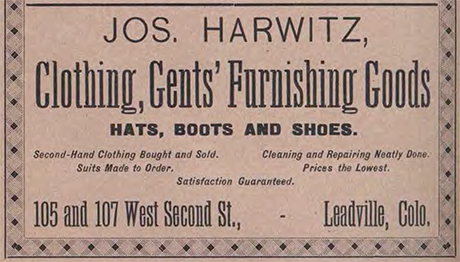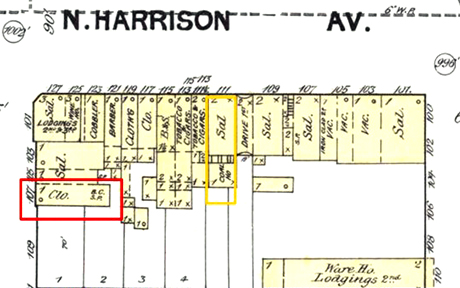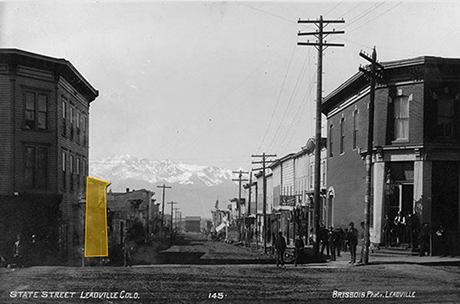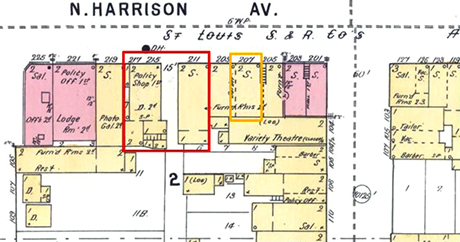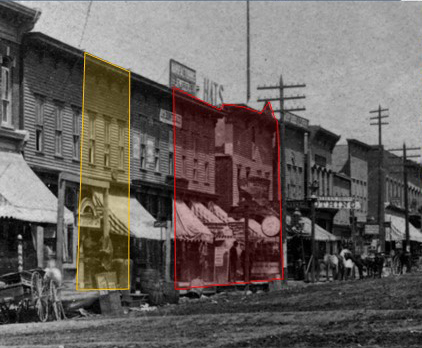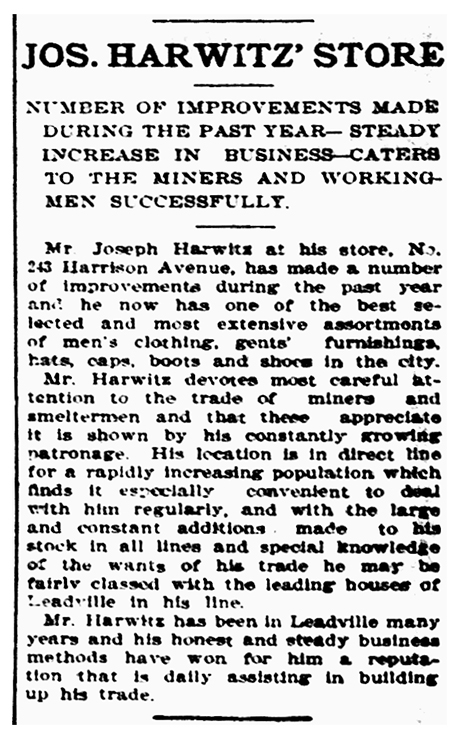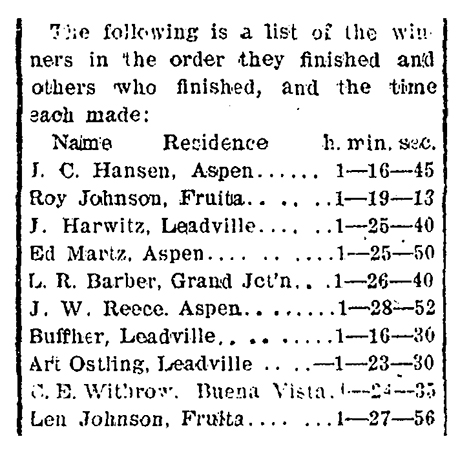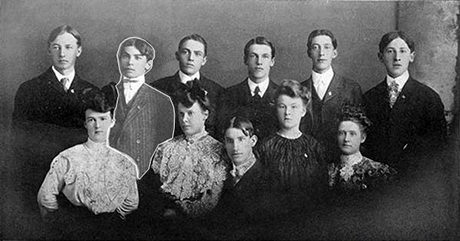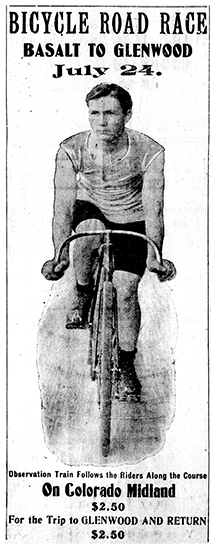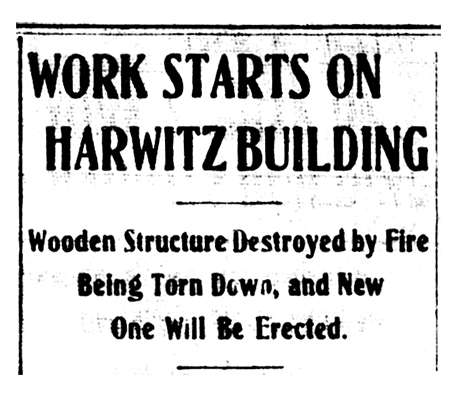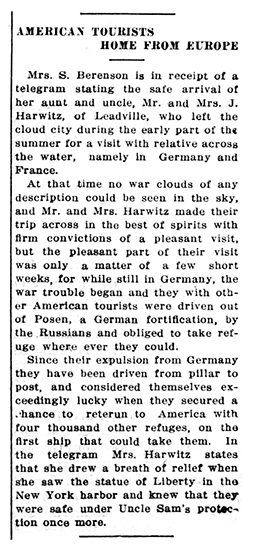Joseph Harwitz [1]
Born: October 14, 1852 (Kalash, Poland) [2]
Died: March 30, 1930 (California)
In Leadville: 1886-1920
Cecilia (nee Kastelow) Harwitz [3]
Born: Unknown
Died: February 20, 1937 (California)
In Leadville: 1886-1920
Grace Harwitz (Minkin) [4]
Born: November 25, 1883 (Germany)
Died: May 1, 1962 (California)
In Leadville: 1886-1908
Alford Harwitz [5]
Born: 1883 (Germany)
Died: December 6, 1886 (Leadville)
In Leadville: 1886
Goldie Harwitz [6]
Born: 1885 (Germany)
Died: December 15, 1886 (Leadville)
In Leadville: 1886
Jacob Harwitz [7]
Born: November 12, 1885 (Germany)
Died: March 29, 1978 (California)
In Leadville: 1886-1908
Able Harwitz [8]
Born: July 22, 1888 (Leadville)
Died: July 29, 1888 (Leadville)
In Leadville: 1888
Sanford (Sam) Harwitz [9]
Born: December 8, 1890 (Leadville)
Died: September 22, 1940 (California)
In Leadville: 1886- 1912
Bertha Harwitz (Friedman) [10]
Born: May 9, 1896 (Leadville)
Died: February 20, 1986 (California)
In Leadville: 1886-1920
The Joseph Harwitz family was a German-Russian Polish family which arrived in Leadville in 1886. The patriarch, Joseph, was a tailor and merchant who endured over 30 years of tumultuous, but ultimately moderately successful business in the frontier city of Leadville. The family endured the loss of three children in infancy as well as the loss of a house to fire. According to the first available census information for the family, Grace and Jacob, the eldest two children, were born in Germany in 1882 and 1886 respectively. [11] A child named Alford also immigrated with the family but died soon after their arrival. According to a 1914 Passport application, they came to America from Germany on May 31, 1886 and were probably situated in Leadville by sometime in the summer or fall. Joseph Harwitz appears first in the 1887 Leadville city directory as a tailor located at 111½ Harrison Avenue. [12] To support the 1886 arrival date, the 1900 census identifies the immigration year of the entire family as 1886. Additionally, a 3-year-old child named Alford was interred in Leadville’s Hebrew Cemetery at the end of 1886. [13] This would also indicate that Leadville may have in fact been their specific city of choice for immigration, perhaps as a result of established connections. It would be an extraordinary effort, but not unheard of to immigrate with a newborn child, which son Jacob would have been. The exact residence of the family during 1887 and 1888 is unknown, although the place of business of Joseph was identified in city Directories as 111½ Harrison Avenue. As is well established, many tradesmen and shopkeepers lived in residential quarters above or behind their stores in the 19th century.
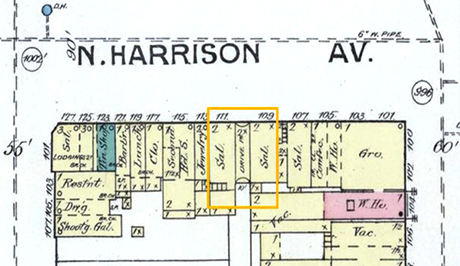
Joseph Harwitz’s tailor shop was documented as located at 111½ Harrison Avenue. It is unclear if the ½ address was the adjoining structure labeled “Drive”, or the 1 story structure in the rear. The family likely lived on the second story of 111 Harrison, or perhaps in the one-story addition in the rear.
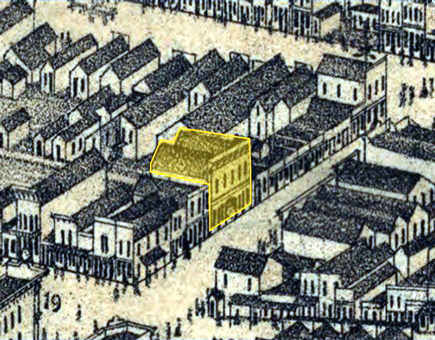
As a secondary note, the area labeled “Drive” was actually a bridge between 111 and 109. Such bridge-like passages existed elsewhere in Leadville at the time, including between the Clarendon Hotel and Tabor Opera House and at the Smith Lumberyard on Poplar and East 8th Street. 111 Harrison can be identified in this I879 birds eye view, as the two-story structure with the arched passage in the middle.
Interestingly, Joseph’s 5-year-old daughter was the first family member to appear in local newspapers; predating her father’s clothing store ads. Gracie was listed as a member of an elementary school performance which presented a series of songs at the Tabor Opera House in May of 1887. [14] This suggests the speed to which the child was integrated into American culture. It is unknown if Gracie or her parents were able to speak English at this early stage in their arrival, (their native tongue was German) but Gracie was likely conversant enough in English to participate in several of the songs the children sang. By October of 1887, Joseph began to publish advertisements for his clothing store. His early ads frankly suggested that customers bring old clothes to him for repairs and re-sale. These ads ran regularly in the Daily/Evening Chronicle before they abruptly stopped in November.
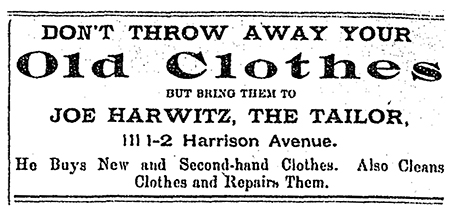
Advertisement for “Joe Harwitz, the tailor”.
Leadville Evening Chronicle. October 7, 1887. Page 4.
While there are no documented ads for his store during 1888, Joseph continued to operate at 111½ Harrison that year, according to the City Directory. [15] While the family did not appear in newspapers during 1888, they lost a 7 day old child named Able in July and 3 year old child named Goldie in December, as evidenced by burials in Leadville’s Hebrew Cemetery. [16]
By 1889, Joseph’s wife Cecilia made her first appearance in local newspapers when she detected nefarious actives in the store at 111½ Harrison. During the morning on a late January day, two young men entered Joseph’s store and according to a reporter, the two men devised a method for stealing a series of items,
“…One of them engaged Mr. Harwitz’s attention while the other helped himself to gloves, hats, socks, and anything else he had a mind to. He would shove them up under his coat, walk to the door in the most nonchalant style imaginable, lay the stolen articles down on the pavement and return for another load of plunder… Mrs. Harwitz entered the store and soon detected his pilfering. She seized him and a general scrimmage ensued between Mr. and Mrs. Harwitz and the two men…”
A nearby police officer came to the aid of the shopkeepers and took the perpetrators- identified as Frank Brown and James Byron- to the county jail. [17] An interesting variant of the story appeared in a later edition of the Daily/Evening Chronicle. In that article, the perpetrators were reported to have been drunk while engaged in their stealing. Additionally, a character named M. Rosenbloom entered the scrimmage when he, “…drew a gun and cracked Burns [Byron] over the head…”. M. Rosenbloom may have been an individual listed as a tailor in the store of A. Kertz at 106 Harrison Avenue in the 1888 city directory. [18] Perhaps he was engaged as a tailor in Joseph’s store by 1889; although he does not appear in that year’s city directory. At some point during 1889 following the incident with the thieves, Joseph moved his store, and potentially the family, to a location at 107 W. 2nd Street. [19] This move was completed by July 1889 as suggested by a modified advertisement for his tailoring services in the Herald Democrat. [20]
While advertisements or appearances in local newspapers were not found during 1890, Joseph advertised in the 1890 and 1891 city directories. [21] Additionally, a son named Sanford Jacob Harwitz (always written as Sam) was born to Joseph and Cecilia in December, according to a draft registration card. [22] His shop description expanded from simple “tailor” to “merchant tailor and men’s furnisher” in 1890 and was equally expansive in 1891. In 1891, the store expanded from 105 W. Second to neighboring 107 W. Second Street. The new location on W. Second was very close to the former; indeed, it was simply around the corner (see map).
The Harwitz family made another appearance in local newspapers during August of 1891 as a result of a theft. On the 19th of that month, a man stole twenty silk handkerchiefs from fellow German Jewish clothing dealer Isidore Grossmeyer. [23] He immediately went a few blocks to sell the item to Joseph for $7.50. When Isidore discovered the handkerchief was missing he, “…made a tour of the second hand stores, and found his goods at Harwitz’s…”. Although Isidore had identified the crime, Joseph refused to give the handkerchief back, and Isidore issued a replevin to the police. After being visited by Marshall McDonnell, Joseph decided to comply, and helped to identify the perpetrator. When officers traced the thief to the Harrison Reduction Works on Toledo Street, he removed several layers of clothing and ran. The thief’s speed was noted by the reporter; he managed to outrun the officers and was at the intersection of Orange and East 7th when he disappeared. The thief’s running ability is probably testament to the exceptional physical condition smelter workers were able to maintain shoveling coal or doing other hard manual labor, even in the doubtlessly smokey and hazardous breathing conditions of such a job. The article concludes with a warning about dealing in stolen items, identified as a common occurrence among secondhand dealers of the city. [24]
Later in 1891, Joseph was listed as a defendant in a police court notice after he failed to purchase a secondhand store license. [25] During this same time frame, fellow Jewish secondhand dealer Abraham Isaacs was also engaged in a protracted protest with city officials regarding licensing fees for “junk stores”. [26] While Joseph may have been less feisty than Abraham in protest of the fees, such trials show that these fees and ordinances were often overlooked or ignored by shopkeepers. Indeed, Abraham was a neighbor during this time with a tailor and secondhand store at 117 Harrison Avenue. The district of stores on the 100 and 200 blocks of Harrison was a microcosm of retail activity, and was colorfully described several years earlier by reporters as,
“A procession of these small houses, with raiment of every conceivable shape, from the discarded bum’s pants to the shining swallow tail, arranged before their doors with figures appended makes it the Chatham quarters of Leadville.” [27]
While Joseph’s store was likely a step up from the “junk stores” referred here, it is clear there was a vivid and widely diverse class of merchants, thieves, products, and customers in the vicinity. Joseph’s trial eventually went to appeal and was last mentioned in local newspapers in January of 1892; Joseph’s punishment or otherwise was not stated. [28]
In October of 1891, son Jacob, who was a newborn when the family arrived in Leadville in 1886, made his first appearance in local newspapers. He was listed as a “well-behaved student” in a local school notice- he was probably in 1st grade at the time. [29] For the first time in 1891, two men were listed as employees at Joseph’s store; clerk Joseph Diment and tailor Frank Potocnjak. Both men were also listed as residents of 105-107 2nd; probably a small room in the rear of these stores. Additionally, the directory listed a separate fruit and confectionary store located at 125 Harrison Avenue with Joseph as the proprietor. This store was short lived and only made a single appearance in Leadville city directories. [30] During the summer of 1891, Joseph was naturalized as an American citizen with Adolf Schayer as a witness. [31] During the years Joseph’s store operated at 105-107 West 2nd, a specific listing for the family residence was not provided by the directory enumerator. It is possible the family continued to live in the apartment about the former store at 111 Harrison during these years.
Throughout 1892 and 1893, Joseph and Jacob were mentioned occasionally in local newspapers, Jacob for his academic achievements- he was in middle school by this time- and Joseph ran a series of advertisements for the tailor and clothing store at 103-105 West 2nd Street. In mid-summer of 1893, Joseph and associate S. Blumberg, were sued by Pauline Schwed for lack of rent payment at “lot 20 block 4 St. Louis addition”; probably 122 Harrison Avenue. [32] While a City Directory for the year 1893 is not extant, there is no official evidence Samuel Blumberg or Joseph Harwitz did business or lived at this location. Blumberg was a clerk at the tailor shop of Ed Jackson at 219 Harrison Avenue in 1892 and 1894. [33] However, Blumberg moved to this location later in the 1890s. [34] The suit went to trial in August with an unknown result. [35]
In February 1894, Joseph was listed as a participant in the election of at-large delegates to that year’s Populist party convention. That year, Colorado was one of several Western states including, Oregon, Washington, Nebraska, and Kansas to have Populist Governors. As one of Colorado’s 5 largest cities, Leadville processed a Populist constituency and Joseph was clearly a supporter of that political ideology. [36] That year, only 103 West 2nd Street was listed in the local directory as the location of the store. [37]
Joseph relocated his store to 207 Harrison Avenue in early January of 1895. The advertisement for the move appeared directly below one for fellow Jewish clothing dealers and tailors Abraham Issacs, and Moritz Mankus. [38] Throughout the spring 1895, Joseph’s son Jacob and daughter Grace intermittently appeared in newspapers for minor academic achievements and social gatherings in their respective primary and secondary schools.
In March, an eccentric character used Joseph’s goodwill to commit check fraud. A cigar salesman named B. Felt had “made his headquarters” within Joseph’s store at some point during early 1895. Felt also acted as an unofficial letter writer for Joseph. On one occasion, an individual named Schumann left a $50 check with Joseph for safe keeping while he took a trip to Grand Junction. Schumann eventually wrote to Joseph to send the check and Felt offered to write a reply. Felt volunteered take the letter enclosed with the check to the post office. Instead of sending it, Felt took it for himself and cashed it at the brand new American National Bank building and disappeared. [39] By September of 1895, Joseph appeared among the ranks of Leadville’s Populist supporters as a member of the central committee from the 3rd Precinct. [40] Son Jake appeared in a short announcement at the beginning of November after he completed a project in his 5th grade class to recreate the continents using “sand modelling”. [41] More announcements of the various academic achievements of Sam, Grace and Jake appeared during the remainder of 1895 and 1896. During 1895, Joseph took an interest in religion, and was listed as the vice-president of Temple Israel congregation in the 1895 Leadville local magazine Lake County and the Gold Belt. [42]
In the mid-summer of 1896, a shooting at a saloon across Harrison from Joseph’s shop left one bullet lodged in his front door. [43] The following month, “a young man who has a weakness for pants” visited Joseph’s stores. However, instead of paying he surreptitiously put on “pants of a wallpaper variety” in layers while hidden in the back of the store. Joseph easily detected the thief, performed a variety of citizen’s arrest, and delivered him to the police. [44] Several days later, Joseph again participated in a Populist party caucus convened under the premise of the “Great Fight for Free Silver”. [45] Joseph nor the family appear in newspaper notices for the remainder of 1896.
In late January 1897, fellow German Jewish merchants Isaac and Mina Kahn [46] celebrated their 31st Wedding anniversary at their store on East 6th Street. A number of Leadville’s merchants and Jewish residents attended; among them was Joseph’s wife Cecilia, who to this point appeared very infrequently in local newspapers. [47] Joseph, however, was not listed as an attendee. Indeed, this is only the second time Cecilia was mentioned in a newspaper. While many women during the Victorian era were bound to their husbands by social restrictions we are unfamiliar with today, many women of the era also led comparatively independent lives; often in the form of charitable, social, or literary clubs. While men had gender segregated clubs of their own, some types of mixed clubs and socializing did occur. Men and women were often relatively equal participants in political meetings, (although women never held leadership positions in politics), club committees, and charitable causes. While women were given more social freedom during the late 19th Century than modern norms give credit, a majority were indeed confined to homemaking; thus rarely appeared in newspapers. If they did appear, they were listed under their husband’s name. We have seen evidence that Cecilia Harwitz was involved with operation of the store. This was demonstrated when she caught a thief in 1890, as related above. This was probably a fairly common arrangement, with husband and wife teams managing family and business life on relatively equal terms. At least one other Leadville Jewish merchant’s wife (Sandusky) actually owned the store, with the husband providing the day to day management and general labor. [48]
On May 1, son Samuel (Sanford) appeared in local newspapers as a participant in the Arbor Day celebration at Central School. The headline claimed, “There were no trees or flowers, but the children had a good time just the same” Samuel was listed as a participant in a song and dance titled “The Rainy Arbor Day”. Hundreds of children from Leadville’s three urban primary schools performed individual songs or dialogues about flowers, sun, and trees; themes probably welcome after the deep winters Leadville is often subjected to. [49] While it was identified as an Arbor Day celebration, the themes were clearly more in line with May Day or other spring celebrations.
That summer, son Jake appeared as the winner of a running broad jump competition against a visiting team from Denver. The tournament was organized by the Colorado state Turnverein club- a German American athletic club popular among Jewish as well other German speaking immigrants and their families in the late 19th and early 20th Centuries. In a “sack race” Jake and Sam were listed as the top two finishers. During 1897, the family made their home at 117 West 3rd Street. [50]
In the spring of 1898, Joseph was listed as a jury member in the trial of two men accused of armed robbery at a State Street saloon. [51] The year 1898 passed quietly in terms of newspaper mentions and, by the end of the year, youngest daughter Bertie appeared as a first grade student at Central School. [52]
In the early spring of 1899, Joseph again appeared as a delegate from the 3rd Precinct of the Leadville Populist Party. [53] Several months later, Joseph purchased the building at 213 Harrison Avenue from Wilhelmina Gude. A report claimed that the building was at the corner of the alleyway at Harrison Avenue and had been built in 1879. [54] For the 4th time in 15 years, he relocated his business and residence that spring. In May, Joseph appeared (spelled Josef) on a list of business establishments which planned to close their doors after 7pm. While a number of Jewish merchants appeared on the list, many were not, and the reason for the announcement of the closure is unknown. In broader history, during the late winter and spring of 1899, the central mountains received a record amount of snow, and the early closures of businesses may have been a result of this.
As Joseph and the family settled into their new building during 1899, they hired a clerk named Morris Abramson, as documented by the city directory. [55] In May, a man entered the store at 213 Harrison and attempted to cash a fraudulent check. Morris and Joseph were subpoenaed to testify about the event. The accused was named Nolan and identified as “advanced in years” and “not the picture of a criminal”. Joseph and Morris testified that he appeared confused and when the jury convicted him, they recommended he be granted clemency. [56]
The year 1900 was sparsely documented in newspapers. However, the United States Census visited the Harwitz residence at 213 Harrison early in the summer and recorded the household was comprised of Joseph aged 52, Cecilia aged 46, Grace aged 17, Jacob 13, Samuel 10, and Bertie 8. In addition, there were three boarders, May Pedon, 16 and a native of Germany, Joseph Chrismore, 28, a native of Austria, and Stephen Frankle, 26, also a native of Austria. It is clear that despite sizable families, many property owners took in young boarders to supplement income. The structure at 213 Harrison was a sizable two-story frame structure with a storefront at the street level and was probably well endowed with space for apartments. In October of 1900, oldest daugher Grace was listed among the attendees of a young women’s party at “Miss Mandy’s” house on West 6th Street. The party was described as “beautifully arranged with garlands and ferns” and included “daitily gowned maidens”. Amoung the attendees were several guests from New York and Denver. The women were entertained with music, cards, fortue telling, and “taking of flash light pictures”. Many historic photos document this late 19th and early 20th century phenomenon in which party attendees sat in the dark while a photographer quickly flashed a photo; subjects often held surprised and humorus expressions. The title of the column in the newspaper was “Of Interest to Women”. [57]
In early 1901, a newspaper reporter visted Joseph to catalogue his business. Among the accolades, it was reproted that Joseph had improved the store and expanded on “extensive assortments of mens clothing, gents furnishings, hats, capes, boots and shoes”. The address was incorrectly written as 243 Harrison, instead of the accurate 213 Harrison. He was recorded as possessing an excellent location to cater to the “rapidly increasing population which finds it especially convenient to deal with him regularly.” Further commentary language follows a journalistic pattern of praise of the time. [58]
In June, Joseph was listed as a member of Leadville’s Lodge 20 of the Knights of Pythias as an elected member with the initals “M.W”. This may have been either a well known abreviation for the position he was elected, or a secret one; it is unclear what it stood for. [59] In late July, eldest daughter Bertie was listed amoung the attendees of a party at the residence of Carrie Mayer on West 7th Street. [60] In attendance were many names familiar to Leadvilles greater Jewish community, including Grossmeyer, Miller, Janowitz, Schayer, and Heimberger. However, others outside the Jewish community also attended. [61] The remainder of the years passed with minor academic mentions of the children, but no significant public announcements.
On January 2, 1902, Joseph’s store at 213 Harrison again appeared in profile as a respected and legacy business. Much of the description was complemntary of Joseph’s business with a short note on the development of the area around his store;
“Despite the numerous changes in the population of Leadville. The older portions of the city, especially on the west side, continue to hold their own, and Mr. Harwitz’s locaiton is a favorable one for the convenience of these sections.”[62]
While 1902 and 1903 remained quiet of social mentions for the family, the store continued to operate with maintained success. Meanwhile, son Jake began to appear with greater frequency as a rising athlete. In late July, Jake was mentioned as a third place finisher in a bicycle road race sponsored by the Colorado Central Railroad in Pitkin and Garfeild Counties. The race, which was part of a bigger athletic carnival, started in Basalt and finished in Glenwood Springs. The reporter commented that many of the Leadville boys who joined there race were thin and unimposing; Jake was in fact refered to as a “stripling”. One boy from Fruita was given the more imposing title of “the big Swede”. Betting was entertained by spectators, and the racers set off in small groups at staggared intervals, one minute to several minutes apart. Racers were listed as from Fruita, Glenwood, Buena Vista, Leadville, Grand Junction. Interestingly, it was reported that a special excursion train followed a leading pack of racers to the finish. [63] Another Glenwood paper reported that Jake won a “high grade rifle as a prize for his third place finish. [64] That autumn, Jake was mentioned for the first time as a member of Leadville High School’s football team and was indeed the quarterback for that season of his senior year (pictured). [65] In December both Bertie and Jake were listed amoung a mix of Jewish and non-Jewish attendees to a surpise party for Edna Adams on West 4th Street; Henry Miller, Sam Bergman, and Grace Mankuss were among the other attendees. [66]
On January 1, 1904, Joseph’s business again appeared as part of the now established tradition of promoting his store with a short biography in the year’s first edition newspaper. Much of the language in the 1904 biography was nearly identical to that of the previous years in accolades.
That May, Jake and a fellow student named James Chamberlain demonstrated a telegraph device at the Tabor Opera House (then known as the Elks Opera House) with the help of the Principal. [67] The event was part of a larger “Cavender Prize” named for the then President of Leadville’s School board, in which students debated philosphy, demonstrated scienctific experiments, and made speeches; the best of which were rewarded with between $15 and $45. The primary topic of debated was “Who contributed more to modern civilization, Greece or Rome?”. In between the experiments and speeches, music students perfored several short concertos. The report of these events was covered by an entire column on the front page of that day’s newspaper, demonstrating strong community support of education and academic performance in Leadville’s schools. Several weeks later, Jake graduated high school in a class of 11, pictured here shortly after their graduation ceremony at the Elks Opera House on June 10th. [68] In mid-July, Jake attended a party of young people at the Lord Ranch. [69] That same day, an advertisement for the annual bicycle race Jake had particiapted in the previous year appeared in Leadville newspapers; the boy in the photo is not identified, but bears some resemblance to Jake. [70]
On July 25, Jake was listed as a second-place finisher in the Basalt to Glenwood race with a time of 1 hour 16 minutes and 45 seconds; and improvement of nearly ten minutes from his previous year’s third place finish time. It was also noted that he was awarded a watch for his second-place position. [71] Another race took place in September and by late August $50 bets were already in position between Jake and a rival Grand Junction racer named Barber. [72] On September 15, it was reported that Jake won the race by 8 seconds. [73]
That year, Jake was recorded in the Leadville directory as a clerk at the Diamond Coal Company; a job he probably took directly out of high school. [74] Curiously, in 1904 a member of the family listed in Leadville directories, but unaccounted for in the census or other records, is “Joseph Harwitz Jr.”. He appeared in directories for several years as a resident of 213 Harrison Avenue. Indeed, it is likely this individual was in fact younger son Sam. Joseph Jr. was listed in the directory between 1904 and 1907 and staring in 1908, Sam was listed, with no trace of Joseph Jr., indicating these were the same person. It is possible Sam was listed as Joseph Jr. during these years because he was employed at several businesses, despite the fact that he had not yet turned 18; he may have been legally required to be listed under his father’s name until he turned 18. [75] This can be further confirmed by the fact that the 1900 census listed the total number of living Harwitz children as 4; Jake, Sam, Bertha, and Grace.
While the Harwitz spotlight of 1903 and 1904 were the life and times of young Jake, the store and family continued to operate and socialize. Joseph and Cecilia were reported in Denver’s Jewish Outlook as hosting former Leadville Jewish community member Mrs. Pelton [76] on a Thanksgiving visit. [77] In March, rarely mentioned eldest daughter Grace appeared at the birthday party of fellow Leadville Jewish clothing merchant Ed Jackson. [78] Other prominent Leadville Jewish individuals such as Isaac and Sol Kahn also were also in attendance. [79] Several weeks later, it was reported that Grace had recently returned from a short trip to Salida. [80] In April, youngest daughter Bertha began to appear in social columns and was listed as an attendee of a party for Christina Monberg and as a student in room 8 of the Central School. [81] In June, Sam was listed as a cast member of a comic opera. Along with Willie Young, Jake Sandusky, and Jack Gould, Sam was noted for his performance of a comedic song entitled “If the Elks Opera House Belonged to Us”. [82] Of special note, was the fact that like Sam Harwitz, Jake Sandusky was also the son of another successful Jewish merchant, Abraham Sandusky. [83] Indeed, the families of both boys came to Leadville and started hardscrabble tailor and clothing shops in the city during the same year, 1886. In October, Jake appeared in a University of Colorado Boulder publication as a member of that school’s athletic association- Jake probably began his education as an electrical engineer at that school in the autumn of 1904 following his graduation from Leadville High School. [84]
While the store continued to operate at 213 Harrison throughout 1905 and 1906, a pant thief visited the family in the spring of 1906, reviving an unfortunate situation which had not plagued Joseph and the store since the 1890s. [85] It was later stated in court that daughter Grace was the individual who caught the thieves as they attempted to steal more clothing from the neighboring clothing store of Bergman’s. [86] Later that summer, Sam was listed in Denver’s Jewish Outlook as on a fishing and camping trip with friends Steven Vontell and Henry Miller. [87] Henry was the son of Nathan Miller, also a prominent Leadville Jewish clothing store owner. [88]
Also that summer, Joseph’s mining interests were revealed when he received a “certificate of redemption” against Doris Gold and the Silver Mining company for $406.85. [89] In October, a University of Colorado publication listed Jake as the manager of the Junior Engineer’s Football team, which aspired to challenge the Senior Engineers to a game that autumn. [90] In October, Joseph donated a suit of clothes to the St. Joseph’s Catholic church fundraiser, suggesting the often cooperative nature of religious individuals and institutions in Leadville at that time. [91] In November, it was announced that Jake had returned home from Boulder after an illness had prevented him from continuing to study. [92]
In early 1907, Bertha was listed among the contributors to construction of a new alcove to the Carnegie Library on 9th Street. [93] Several days later, Jake returned to Boulder after “spending a pleasant vacation with his parents in this city.” [94] During spring break that year, Jake returned to Leadville and participated in a Shack Club social. [95] His studies however did not atrophy as he was listed among a large group of Engineering senior students who visited a series of industrial facilities in Victor, Canon City, Pueblo, Cripple Creek, and Colorado Springs several days after the party at the Shack Club. [96]
While the Harwitz store continued to operate much in the same way as it had since the late 1890s, disaster visited the family in October of 1907 in the form of a large fire. A blaze broke out on the 200 block of Harrison Avenue at 4 am on the morning of October 1. Among the first businesses and individuals listed to have lost property were the personal residence, store, and buildings of Joseph Harwitz, listed as a total loss of $20,000. The original of the fire was a mystery, but it was reported that the first flames were wreathing a shooting gallery next to the Harwitz store at 3:55am. A total of 5 heavy streams of water were on the blaze by 4:30am with the help of Leadville firefighters and volunteers alike. Several people were injured while jumping from second story windows during the fire, including two roomers at the Harwitz residence, Frank Speiglman and Harry White. In panic, Speiglman and White unnecessarily jumped from the second story of the Harwitz residence although an escape was possible through the store, according to a reporter. Chief of Police Kern was injured from an erratic firehose has he attempted to carry it into the upstairs of the Harwitz residence. One woman, May Brown, jumped from a second story window and, while two bystanders tired to catch her, they were pushed by a drunken man and failed to form a “bucket” with their arms. May struck an awning and hit her head on the sidewalk; from which she received deep wounds to her scalp and arm. Grace gathered a box of jewels and watches as she escaped, but in great alarm, she dropped them as she ran down an interior staircase. After the fire was extinguished, Sam recovered the box, and it was considered something of a miracle to have survived the torrents of water which later cascaded from the upper story. Sam was credited with saving the house and surrounding buildings by immediately running from his bed though the burning shop to turn off a gasoline tank located at the rear of the store. After the fire was out, Grace re-entered the second story of the building to recover a set of silver dinnerware; only to find it a completely melted mass. It was reported that Joseph held $1000 in insurance for his structure- and was one of the only individuals to carry any insurance out of the $40,000 in total damage. Joseph’s insurance was unusual due to the fact that rates were so high, many business and property owners simply carried no insurance. A distraught barber of 25 years at 215 Harrison rifled through the ruins of his store for several valuable razor strops and chess pieces. During the fire, a shoe looter was caught by Harry Isaacs in front of Joseph’s store and a fight ensued. Overall, the fire was a destructive one, and clearly a pivotal point in the story of the Harwitz family. [97] Indeed, newspapers throughout the state reported on the fire, including one in Fort Collins, Yuma, and Breckinridge.
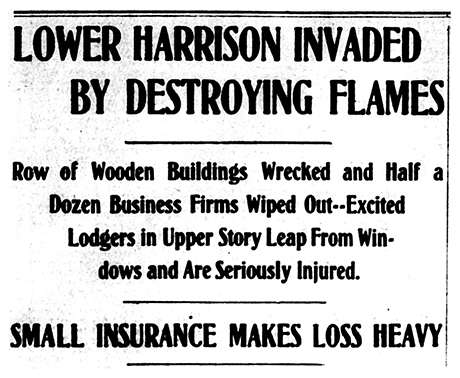
The headline of an article in the Herald Democrat reporting about a devastating fire that affected the Harwitz store.
“Lower Harrison Invaded by Destroying Flames”. The Herald Democrat. October 2, 1907. Pages 1 and 3.

Most of the highlighted structures were severely damaged in the fire on the morning of October 1, 1907. The brick corner building, known as “Sara Rays Block” built by an enterprising washerwoman in 1879 was spared due to the fact that it was brick construction. The Harwitz store was probably the structure in the middle right with the slight peak.
One week later, the cleanup of the block was progressing. The building on the corner of 3rd and Harrison was quickly demolished and, in its place, a new brick structure was planned; in fact, this building still stands on the southwest corner of 3rd and Harrison. It was also reported that Joseph was working to stabilize his building to prevent it from collapsing; hopeful he could build a new shop by the spring. [98] In many ways it is true that this block was never substantially rebuilt and many gaps still exist in the store frontage along this portion of Harrison Avenue. Joseph was ultimately successful in constructing a new store- one which still stands today.
The process of rebuilding was not a straight path, however. In late October, Joseph met with an attorney to discuss liabilities and the adjustments to his under-insured property and subsequent bankruptcy. [99] His efforts payed off, however, and by April the City Council approved construction of a building at 213 Harrison Avenue. [100] On May 7th, the old structure was demolished and a new foundation was laid. While it was reported that rJoseph initially considered building another wood frame structure, a brick one was thought a better deterrent from fire. While the building was originally planned to be a single story, it was given enough strength to potentially have a second story added later. In accordance with an agreement with the city, the new structure was built on the same footprint as the old one. Apparently, the old structure stood as a wreck the entire winter of 1907-1908. While the old lumber was considered for use in the new structure, it was too charred. [101]

The building located at 213 Harrison Avenue still stands today in 2020. The rear addition was originally designed to house the family while they operated the store, but they never moved there—instead living across the street. Currently, the structure belongs to the Trail 100 Race Series company and has been restored.
In July, Jake was again announced as a racer in the annual Basalt to Glenwood bicycle race. [102] Further documentation of this race was not found, however. While he graduated from CU Boulder as an electrical engineer in May, no announcements were published in Leadville newspapers. His photo was paired with the quote “Student first, student last, student all the time, otherwise ‘fusses”. Jake was still listed as a resident of 213 Harrison Avenue that summer. [103] By the autumn of 1908, he was employed by the Central Power company’s transmission line between Shoshone and Denver, according to a CU Boulder alumni announcement. [104]
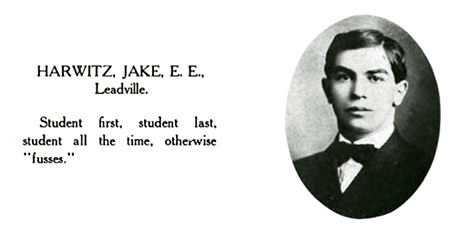
Jake Harwitz as shown in the 1908 yearbook of the University of Colorado.
“U.S., School Yearbooks, 1880-2012”. University of Colorado. Year 1908. Page 167.
During 1909 and 1910, few announcements of the family or store were found in Leadville or state-wide newspapers. Presumably, the new store at the site of the old was completed by the end of 1908. Jake appeared regularly as an attendee of Shack Club parties during both 1909 and 1910. One smoker and banquet in late 1910 was organized specifically for Jake, as he was visiting from his electrical work at Shoshone. [105] The family moved to 220 Harrison Avenue at some point between 1907 and 1910. This structure was also owned by Joseph and was almost directly across the street from the newly built store at 213. The 1910 United States census enumerated the family as Joe aged 58, Cecilia aged 56, Bertha aged 16, Sam aged 20 and employed as a switchman, in addition to two male boarders from Austria, Pete Stolt aged 45 and Pete Clarish aged 23. [106]
In January of 1911, Jake was again in town from Shoshone. This time, it was reported he had grown a moustache, but he was trying to avoid his friends, as they had cut it off last time he was in town. [107] In March, Joseph was listed as a member of a jury for the trial of three Greeks accused of robbing a saloon owner. [108]
According to a 1978 obituary, Jake moved to Sacramento, California in 1911 where he spent the remainder of his life, although this is not documented in Leadville newspapers. [109] In late 1911, a shoe thief visited the store and was identified by Cecelia as he attempted to escape. [110]
In 1912, it was evident Sam had moved to Salida as he was reported as visiting his parents from that city in the spring. [111] One month later, it was reported that Sam was in a Salida hospital to undergo a “slight operation”. In late October or early November, Sam lost his leg in an accident on the Rio Grande railroad at Wolcott. He was again admitted to the Rio Grande Hospital, but this time his condition as not slight. His parents and Bertha were reported to be visiting him in mid-November. [112] Scarcely one week later, Sam was again in Leadville newspapers, this time a rumor was circulating that he had died at the railroad hospital; this was stated to be false. Several days later, Sam was reported by a Grand Junction paper as gaining strength and ready to be up and about on crutches within a week. [113] This optimism would prove to be as unfounded as the rumors of his death. The same week, two friends, Mrs. David Greenwald, and Dave Huston were reported to be visiting Sam with well wishes. [114] Although he was reported as in an improving condition in mid-November, by mid-December his condition deteriorated, and his sister “Mrs. S. A. Minkin” previously known as Grace visited him from Kansas City. [115] By early January, Sam was still bedridden as evidenced by the continued visits from friends and family at that time. [116] Several days later it was announced in a CU Boulder Alumni publication that Jake had accepted a job in Sacramento; although it is unclear if he had already relocated to that city at that time or not. [117] During the time his Sam was in the hospital recovering from his serious injury the previous November, it was never reported that Jake had visited his injured brother. In mid-February, it was reported in a Salida paper that Sam had underwent an operation to remove part of his injured leg, and that he was doing better than before. The paper touted his bravery and cheerfulness throughout his entire convalescence, which now extended to over 3 months. [118]
In March it was reported that Bertha, now a Senior in high school, was in Salida to attend a Leadville High School basketball game and had stopped to visit Sam, still in the railroad hospital there. [119] By April, Sam’s hospital stay continued as he was visited by his mother on the 11th of that month between trains from Denver, according to a Salida paper. [120] By May, a Salida newspaper gave the hopeful prediction that Sam would soon recover, and even added the possibility that he could get around with an artificial leg. [121] While his exact date of release from the hospital in Salida is not known, Sam was back in Leadville by November of 1913. [122] According the city directories, the store continued to operate at 213 Harrison during 1912 and 1913.
In the early summer of 1914, the accumulated years of tribulation in the form of Sam’s injury and the loss of their house and business to fire allowed for a vacation. The Salida Mail reported that Joseph and Cecilia were visiting friends on the way to New York to board a ship for a tour of Europe. On May 25th, Cecilia and Joseph were issued a passport for their trip which was to visit family in Germany and include tours of Norway and France. [123] This was a very unfortunate year to visit Europe as World War I was approaching. Indeed, the war broke out in late July, while Joseph and Cecilia were visiting relatives in Germany. A report in a September issue of the Salida Mail recounted their interesting and harrowing experience in an unraveling Europe. According to the report, Cecila and Joseph were taking refuge with other American tourists in a fort in the Posen state of Germany (part of modern-day Poland) when advancing Russian soldiers forced them to evacuate. Joseph’s passport application cited earlier in this report stated that Joseph’s hometown was indeed “Kalash”, Poland. This many have been a corruption of Kalisz, a city in the Posen region of Poland which was known for its pre-World War II Jewish population. After “being driven from pillar to post”, Joseph and Cecilia finally returned to America via Liverpool on September 11. [124] Cecilia was quoted in the Salida paper that she, “…drew a breath of relief when she saw the statue of Liberty in the New York Harbor and knew that they were safe under Uncle Sam’s protection once more”. [125] It is indeed remarkable to reflect on German American immigrants returning to their homeland after nearly 30 years success and tribulation in America, only to be pushed out by one of the most terrible wars in history.
Their story of escaping war in Europe was interesting and unique enough to also be published in greater detail in the Herald Democrat at the end of September. A reporter claimed, “…their experiences on the trip were unusual and varied enough to fill a book with intense interest.” According to the Leadville report, Joseph and Cecilia were visiting Breslau, Germany (modern day Wroclaw, Poland) when the fighting broke out; initially, the biggest inconvenience was the fact that civilian train service was suspended to make room for troop transport. They were not alarmed and simply stayed an extra month as “breastworks went up and soldiers gathered”. As noted by the Salida paper, they were eventually forced out of Wroclaw by advancing Russian troups and began a circuitous train route back to Liverpool which included Berlin, Amsterdam, Rotterdam and other cities away from the front. It was reported that they were issued small American flags by the American embassy in Berlin to identify themselves against “intersession by the police”. However, one night in Wroclaw a suspicious German policeman arrested Joseph under the suspicion he was an Allied spy. While he was being taken to jail, a friend recognized him in the street. The friend vouched for him, and he was released; the only unpleasant incident he claimed to have encountered. A stay in Amsterdam was recounted as sub-par, but their dingy boarding house “had a really good breakfast”.
Throughout their travels in Europe, Joseph and Cecilia’s passports were constantly inspected, and on one occasion their value was made clear when an innkeeper in Liverpool admitted his maid had stolen them in an effort to create a forgery. On the return journey they were sent to steerage by a spiteful crew; their German origin was not well regarded by the English despite their American passports. While in steerage, they spoke with many “American negros” who were on vacation in Europe at the time of the outbreak of war- many of whom preferred the treatment they received in Europe over that in America. A petition against the evacuation ship was circulated among several American newspapermen who were also forced into steerage with the black people and Germans. When the captain heard of the petition, he forced the reporters to destroy the document. A final interesting juxtaposition of history was found at the end of the report relating to their experience in Europe. Joseph commented that he took amusement in the European custom of tipping; “To get any courteous service, one must tip” and that he thought most American would find the practice “obnoxious”. This is in interesting contrast to the present, in which tipping customs are quite opposite. Joseph and Cecilia were quoted as “happy to be back in Leadville” by late September. [126]
In December, Sam was announced to be taking a trip to “the southland” which was defined as Texas and Mexico. Clearly despite the loss of his leg several years earlier, he was fairly mobile. [127] He returned from his trip to Mexico in late January 1915; it was reported that he had “taken in the winter races and other attractions” in Juarez Mexico during the previous several months. [128] In February, Cecilia was called in to testify as a witness of a murder which had occurred in Buena Vista the previous June. [129]
Social notices of the Harwitz family dropped off significantly starting in 1916. The single notice for that year referred to a trip Joseph and Bertha took to Denver in late January. [130]
The next mention of the family did not occur until nearly one year later, on January 28th 1917 when a short notice indicated that Sam had visited the Western Stock show in Denver the previous week. [131] Several months later, the United States joined the ongoing war in Europe and Sam filled out a draft card despite the fact he was probably exempt due to his missing leg; a fact prominently noted on the card. This is also one of the only documents in which Sam is referred to as Sanford- his legal name. [132]
In July, a social notice revealed that Sam traveled to Denver to work as “an advance man for the Dixie Hawaiians”. According to an ad for the Isis Theater in Aspen, the Dixie Hawaiians were a musical group and Sam had clearly been hired by the group to arrange their bookings for the Denver leg of their tour. [133] Further down the same personal mention column of the Herald Democrat it was announced that Jake had recently taken an exam to enter military service in the reserve Corps of Engineers while based in Los Angles. [134] Indeed, his draft registration card from June of 1917 indicated he was a resident of Sacramento at the time. [135] The following day, an announcement in the Herald Democrat indicated that Cecilia intended to close the store at 8pm on weekdays; this indicates that Joseph may have partially retired as the primary shopkeeper at the store at 213 Harrison Avenue at this time. [136] In 1917, Sam, Bertha, Cecilia, and Joseph were all listed as residents of 220 Harrison Avenue and employed at the store at 213 Harrison. [137]
During the entirety of 1918, the family did not appear in social notices anywhere in the state of Colorado but were recorded in that year’s city directory without change from the previous year. The store employed one clerk that year, Don Valencia; a resident of the Clarendon Hotel. [138] 1918 was the final year in which a city directory was published in Leadville.
In May of 1919, a “foreign born youth”, -an Austrian named Tony Harrot- smashed the windows of several businesses on Harrison Avenue including the Harwitz store. The youth also was reported to have stolen a set of hats, shirts, and shoes. In addition, the same youth was arrested for breaking the windows of two other Jewish owned businesses; those of Abraham Sandusky and Hyman Isaacs. The concentration of these businesses was the likely reason they happened to be all Jewish stores and there is no indication of prejudice. The young man was arrested for disorderly conduct and larceny. [139] The event was widely covered in local newspapers and was recounted for several days following the crimes.
The year 1919 was the final one in which Joseph and Cecilia operated the store at 213 Harrison. An announcement signed by Joseph in early January of 1920 read in part,
“Please take notice that I have sold my stock of goods at 213 Harrison Avenue to Max Epstein”.
The 1920 United States census visited the family several days before Joseph sold the stock of the store and enumerated the family as residents of 220 Harrison Avenue and Joseph aged 67, Cecilia aged 65 and Bertha aged 24. [140]
Following their 35-year residence in Leadville, Joseph and Cecilia relocated to southern California. Joseph passed away in March of 1930 and was buried in Los Angles’ Mount Zion Cemetery. Cecilia passed away in February of 1937 and was buried next to Joseph.
Eldest daughter Grace lived in Missouri and Kansas with her husband Max Minkin. It is not believed that the couple had children. She eventually moved to Los Angeles, where she passed away in 1962.
Jake lived the remainder of his life in Sacramento where he was employed as the county electrician between 1939 and 1956. In 1957 he became the “Venerable Master” of the Sacramento chapter of the Scottish Rite, and honor for which his photo was published in the Sacramento Bee. He passed away at the age of 92 in March 1978 and was buried in Old Auburn Cemetery in Auburn, California. [141]
Bertha married a man named Friedman and spent much of her adulthood in California. She was the longest lived of the Harwitz children when she passed away in California in February of 1986.
An invalid the remainder of his life, Sam never married. He traveled extensively, however. He passed away in California in 1940.
The Joseph Harwitz family are exemplary of the tenacity of a Jewish family on the edge of civilization, who ultimately built their part of Leadville into a successful city.
1 Find a Grave, database and images (https://www.findagrave.com : accessed 01 June 2020), memorial page for Joseph Harwitz (unknown–6 Mar 1930), Find a Grave Memorial no. 113215874, citing Mount Zion Cemetery, Los Angeles, Los Angeles County, California, USA ; Maintained by Larry Luna (contributor 46794307).
2 National Archives and Records Administration (NARA); Washington D.C.; Roll #: 213; Volume #: Roll 0213 - Certificates: 31509-32408, 25 May 1914-01 Jun 1914 Ancestry.com. U.S. Passport Applications, 1795-1925 [database on-line]. Lehi, UT, USA: Ancestry.com Operations, Inc., 2007.
3 Find a Grave, database and images (https://www.findagrave.com : accessed 28 May 2020), memorial page for Celia Harwitz (unknown–20 Feb 1937), Find a Grave Memorial no. 113215774, citing Mount Zion Cemetery, Los Angeles, Los Angeles County, California, USA ; Maintained by Larry Luna (contributor 46794307).
4 Ancestry.com. California, Death Index, 1940-1997 [database on-line]. Provo, UT, USA: Ancestry.com Operations Inc, 2000. Original data: State of California. California Death Index, 1940-1997. Sacramento, CA, USA: State of California Department of Health Services, Center for Health Statistics.
5 Find a Grave, database and images (https://www.findagrave.com : accessed 01 June 2020), memorial page for Alford Harwitz (unknown–6 Dec 1886), Find a Grave Memorial no. 18472013, citing Hebrew Cemetery, Leadville, Lake County, Colorado, USA ; Maintained by Michael Harrington (contributor 46760007).
6 Find a Grave, database and images (https://www.findagrave.com : accessed 01 June 2020), memorial page for Goldie Harwitz (unknown–15 Dec 1886), Find a Grave Memorial no. 18472023, citing Hebrew Cemetery, Leadville, Lake County, Colorado, USA ; Maintained by Michael Harrington (contributor 46760007).
7 Find a Grave, database and images (https://www.findagrave.com : accessed 01 June 2020), memorial page for Jake Harwitz (12 Nov 1885–29 Mar 1978), Find a Grave Memorial no. 47719312, citing Old Auburn Cemetery, Auburn, Placer County, California, USA ; Maintained by Glenda Ragan (contributor 47164677).
8 Find a Grave, database and images (https://www.findagrave.com : accessed 01 June 2020), memorial page for Able Harwitz (unknown–29 Jul 1888), Find a Grave Memorial no. 18471816, citing Hebrew Cemetery, Leadville, Lake County, Colorado, USA ; Maintained by Michael Harrington (contributor 46760007).
9 Ancestry.com. California, Death Index, 1940-1997 [database on-line]. Provo, UT, USA: Ancestry.com Operations Inc, 2000. State of California. California Death Index, 1940-1997. Sacramento, CA, USA: State of California Department of Health Services, Center for Health Statistics.
10 Ancestry.com. California, Death Index, 1940-1997 [database on-line]. Provo, UT, USA: Ancestry.com Operations Inc, 2000. Original data: State of California. California Death Index, 1940-1997. Sacramento, CA, USA: State of California Department of Health Services, Center for Health Statistics.
11 Year: 1900; Census Place: Leadville, Lake, Colorado; Page: 16; Enumeration District: 0044; FHL microfilm: 1240125 Ancestry.com. 1900 United States Federal Census [database on-line]. Provo, UT, USA: Ancestry.com Operations Inc, 2004.
12 1887 Leadville City Directory p. 141
13 https://www.findagrave.com/memorial/18472013/alford-harwitz
14 “Very Creditable Showing” Leadville Daily/Evening Chronicle, May 2, 1887 p. 2
15 1888 Leadville City Directory p. 138
16 Find a Grave, database and images (https://www.findagrave.com : accessed 01 June 2020), memorial page for Goldie Harwitz (unknown–15 Dec 1886), Find a Grave Memorial no. 18472023, citing Hebrew Cemetery, Leadville, Lake County, Colorado, USA ; Maintained by Michael Harrington (contributor 46760007) . and Find a Grave, database and images (https://www.findagrave.com : accessed 01 June 2020), memorial page for Able Harwitz (unknown–29 Jul 1888), Find a Grave Memorial no. 18471816, citing Hebrew Cemetery, Leadville, Lake County, Colorado, USA ; Maintained by Michael Harrington (contributor 46760007).
17 “Two Slick Young Men” Leadville Daily/Evening Chronicle, January 28, 1889 p. 3
18 1888 Leadville City Directory p. 225
19 1889 Leadville City Directory p. 135
20 “Joe Harwitz” Herald Democrat, July 2, 1889 p. 2
21 1890 Leadville City Directory opposite p. 184 and 1891 Leadville City Directory opposite p. 269
22 Registration State: Colorado; Registration County: Lake; Roll: 1561833 Ancestry.com. U.S., World War I Draft Registration Cards, 1917-1918 [database on-line]. Provo, UT, USA: Ancestry.com Operations Inc, 2005.
23 For more information on the Grossmeyer family, see http://jewishleadville.org/grossmayer.html
24 “A Long Chase” Herald Democrat, August 20, 1891 p. 5
25 “Police Court” Herald Democrat, October 3, 1891 p. 2
26 For more information on Abraham Isaacs see http://jewishleadville.org/isaacs.html
27 “Abraham’s Ills” Carbonate Chronicle, October 31, 1885 p. 7
28 “Court Calendar” Herald Democrat, January 6, 1892 p. 5
29 “Schools of the City” Herald Democrat, October 4, 1891 p. 2
30 1891 Leadville City Directory p. 269
31 National Archives at Denver; Broomfield, Colorado; Naturalization Records, Colorado, 1876-1990; ARC Title: Naturalization Cards, 1880 - 1906; NAI Number: 1307044; Record Group Title: Records of the Immigration and Naturalization Service, 1787 - 2004; Record Group Number: 85 Ancestry.com. Colorado, State and Federal Naturalization Records, 1868-1990 [database on-line]. Lehi, UT, USA: Ancestry.com Operations, Inc., 2016.
32 “Two Suits Filed” Herald Democrat, June 6, 1893 p. 5
33 1892 Leadville City Directory p. 72 & 1894 Leadville City Directory p. 72
34 “Blumberg” Temple Israel biography, http://jewishleadville.org/blumberg.html
35 “District Court” Herald Democrat, August 9, 1893 p. 6
36 “Populist Caucus” Herald Democrat, February 28, 1894 p.6
37 1894 Leadville City Directory p. 135
38 “Removal!” Herald Democrat, January 2, 1895 p. 6
39 “Mr. Felt Takes a Journey” Herald Democrat, March 31, 1895 p. 3
40 “The Populists in the Ring” Herald Democrat, September 27, 1895 p. 8
41 “Our City Public Schools” Herald Democrat, November 5, 1895 p. 3
42 Lake County and the Gold Belt p. 108
43 “Death Ends a Drunken Spree” Herald Democrat, June 15, 1896 p. 6
44 “Took Four Pairs of Pants” Herald Democrat, June 21, 1896 p. 6
45 “The Populists Select Delegates” Herald Democrat, June 26, 1896 p. 8
46 For more information on the Isaac Kahn family, see http://jewishleadville.org/kahn.html
47 “The World of Society” Herald Democrat, January 24, 1897 p. 6
48 See the biography for the Sandusky family at, http://jewishleadville.org/sandusky.html
49 “Schools Celebrate Arbor Day” Herald Democrat, May 1, 1897 p. 2
50 1897 Leadville City Directory p. 150
51 “Geary Case Holds the Boards” Herald Democrat, March 15, 1898 p. 6
52 “Leadville Public Schools Honor Roll for November” Herald Democrat, December 12, 1898 p. 4
53 “Populist Committee” Herald Democrat, March 12, 1899 p. 8
54 “Of Local Interest” Herald Democrat, April 20, 1899 p. 8
55 1899 Leadville City Directory p. 64
56 “A Busy Court Day” Herald Democrat, December 19, 1899 p. 5
57 “Of Interest to Women” Herald Democrat, October 14, 1900 p. 6
58 “Jos. Harwitz Store” Herald Democrat, January 1, 1901 p. 3
59 “Among the Lodges” Carbonate Chronicle, June 3, 1901 p. 8
60 For more information on the Mayer family, see http://jewishleadville.org/mayer.html
61 “Society” Carbonate Chronicle, July 22, 1901 p. 8
62 “The Harwitz Store” Herald Democrat, January 1, 1902 p. 8
63 “The Road Race” Aspen Daily Times, July 28, 1903 p. 4
64 “Successful Road Race” Glenwood Post, August 1, 1903 p. 1
65 “Public School Column” Herald Democrat, November 22, 1903 p. 4
66 “Society” Herald Democrat, December 6, 1903 p. 5
67 “A Debate for Prizes” Herald Democrat, May 28, 1904 p. 1
68 “Around the City” Herald Democrat, June 10, 1904 p. 5
69 “Society” Herald Democrat, July 17, 1904 p. 9
70 “Bicycle Road Race” Herald Democrat, July 17, 1904 p. 8
71 “Glenwood Road Race” Daily Sentinel (Grand Junction), Volume 11, July 25, 1904 p. 2
72 “Championship Road Race!” New Castle Nonpareil, August 27, 1904 p. 1
73 “Road Race Run” Avalanche - Echo, Volume XVIII, Number 38, September 15, 1904 p.1
74 1904 Leadville City Directory p. 161
75 1904-1908 Leadville City Directory
76 For more information on the Pelton family see http://jewishleadville.org/pelton.html
77 “Leadville” Jewish Outlook, Volume 2, Number 6, December 9, 1904 p. 9
78 For more information on Ed Jackson see http://jewishleadville.org/jackson.html
79 “Society” Herald Democrat, March 12, 1905 p. 10
80 “Personal Mention” Herald Democrat, March 26, 1905 p. 10
81 “Society” Herald Democrat, April 2, 1905 p. 10
82 “Juvenile Comedic Opera Given by Local Talent” Herald Democrat, June 14, 1905 p. 6
83 For more information on the Sandusky family, see http://jewishleadville.org/sandusky.html
84 “Athletic Association” Silver and Gold - University of Colorado Boulder, Volume XIV, Number 4, October 5, 1905 p. 10
85 “Amateur Hold Up” Herald Democrat, May 31, 1906 p. 6
86 “Clothes Thieves” Herald Democrat, June 3, 1906 p. 6
87 “Leadville” Jewish Outlook, Volume 3, Number 42, August 17, 1906 p. 10
88 For more information on the Miller family, see http://jewishleadville.org/miller.html
89 “Around the City” Herald Democrat, September 12, 1906 p. 6
90 “Engineering” Silver and Gold - University of Colorado Boulder, Volume XV, Number 6, October 17, 1906 p. 16
91 “Were you a Prize Winner at St. Joseph’s Fair?” Herald Democrat, October 18, 1906 p. 7
92 “Personal Mention” Herald Democrat, November 8, 1906 p. 6
93 “Leadville’s Public Library” Herald Democrat, January 1, 1907 p. 26
94 “Personal Mention” Herald Democrat, January 1, 1907 p. 2
95 “Society” Herald Democrat, March 24, 1907 p. 8
96 “Students Inspect Canon City Enterprises” Canon City Record, Volume 30, Number 13, March 28, 1907 p. 6
97 “Lower Harrison Invaded by Destroying Flames” Herald Democrat, October 2, 1907 pp. 1 and 3
98 “Clearing Away Debris” Herald Democrat, October 11, 1907 p. 5
99 “Harwitz Adjustment” Herald Democrat, October 31, 1907 p. 5
100 “Are Names In Payroll” Herald Democrat, April 22, 1908 p. 1
101 “Work Starts on New Harwitz Building” Herald Democrat, May 7, 1908 p. 2
102 “Leadville Riders Will Enter” Herald Democrat, July 21, 1908 p. 5
103 1908 Leadville City Directory p. 150
104 “Engineers” Silver and Gold - University of Colorado Boulder, Volume XVII, Number 9, November 12, 1908 p. 12
105 “Entertain Visiting Member” Herald Democrat, November 9, 1910 p. 5
106 Year: 1910; Census Place: Leadville Ward 1, Lake, Colorado; Roll: T624_121; Page: 1B; Enumeration District: 0068; FHL microfilm: 1374134 Ancestry.com. 1910 United States Federal Census [database on-line]. Lehi, UT, USA: Ancestry.com Operations Inc, 2006.
107 “Personal Mention” Herald Democrat, January 7, 1911 p. 3
108 “Three Greeks Acquitted of Robbing Kovak’s Saloon” Herald Democrat, March 11, 1911 p. 5
109 “Obituaries” Sacramento Bee, March 31, 1978 p. 68
110 “Around the City” Herald Democrat, December 21, 1911 p. 5
111 “Personal Mention” Herald Democrat, April 2, 1912 p. 3
112 “Salida News Notes” Salida Record, Volume XXX, Number 29, November 15, 1912 p. 6
113 “Chipped from Exchanges” Salida Record, Volume XXX, Number 30, November 22, 1912 p. 2
114 “Salida News” Salida Record, Volume XXX, Number 30, November 22, 1912 p. 6
115 “Salida News Notes” Salida Record, Volume XXX, Number 33, December 13, 1912 p. 5
116 “Salida News Notes” Salida Record, Volume XXX, Number 36, January 3, 1913 p. 6
117 “News in Brief” Silver and Gold - University of Colorado Boulder, Volume XXI, Number 43, January 13, 1913 p. 2
118 “Local News Notes” Salida Mail, Volume XXXIII, Number 73, February 19, 1913 p. 3
119 “Salida News Notes” Salida Record, Volume XXX, Number 45, March 7, 1913 p. 4
120 “Local Happenings and Social Events” Salida Mail, Volume XXXIII, Number 87, April 11, 1913 p. 3
121 “Local Happenings and Social Events” Salida Mail, Volume XXXIII, Number 94, May 6, 1913 p. 3
122 “Local News Notes” Salida Mail, Volume XXXIV, Number 50, November 25, 1913 p. 3
123 National Archives and Records Administration (NARA); Washington D.C.; Roll #: 213; Volume #: Roll 0213 - Certificates: 31509-32408, 25 May 1914-01 Jun 1914 Ancestry.com. U.S. Passport Applications, 1795-1925 [database on-line]. Lehi, UT, USA: Ancestry.com Operations, Inc., 2007.
124 Year: 1914; Arrival: New York, New York, USA; Microfilm Serial: T715, 1897-1957; Line: 10; Page Number: 91 Source Information Ancestry.com. New York, Passenger and Crew Lists (including Castle Garden and Ellis Island), 1820-1957 [database on-line]. Provo, UT, USA: Ancestry.com Operations, Inc., 2010.
125 “American Tourists Home From Europe” Salida Mail, Volume XXXIV, Number 31, September 18, 1914 p. 1
126 “Caught In War Cyclone” Herald Democrat, September 25, 1914 p. 6
127 “Personal Mention” Herald Democrat, December 2, 1914 p. 3
128 “Personal Mention” Herald Democrat, January 29, 1915 p. 6
129 “No Jury in Jaunick Murder Case” Carbonate Chronicle, February 1, 1915 p. 2
130 “Personal Mention” Herald Democrat, January 23, 1916 p. 2
131 “Society” Herald Democrat, January 28, 1917 p. 2
132 Registration State: Colorado; Registration County: Lake; Roll: 1561833 Ancestry.com. U.S., World War I Draft Registration Cards, 1917-1918 [database on-line]. Provo, UT, USA: Ancestry.com Operations Inc, 2005.
133 “Personal Mention” Herald Democrat, July 11, 1917 p. 3 and “The Isis Tonight” Aspen Democrat-Times, June 28, 1917 p. 4
134 “Personal Mention” Herald Democrat, July 11, 1917 p. 3
135 Registration State: California; Registration County: Sacramento; Roll: 1531278; Draft Board: 2 Ancestry.com. U.S., World War I Draft Registration Cards, 1917-1918 [database on-line]. Provo, UT, USA: Ancestry.com Operations Inc, 2005.
136 “Notice” Herald Democrat, July 12, 1917 p. 5
137 1917 Leadville City Directory p. 142
138 1918 Leadville City Directory p. 250
139 “Youth Smashes Four Windows- Lands in Jail” Herald Democrat, May 4, 1919 p. 5
140 Year: 1920; Census Place: Leadville Ward 1, Lake, Colorado; Roll: T625_165; Page: 3A; Enumeration District: 80 Ancestry.com. 1920 United States Federal Census [database on-line]. Provo, UT, USA: Ancestry.com Operations, Inc., 2010. Images reproduced by FamilySearch.
141 “Obituaries” Sacramento Bee, March 31, 1978 p. 68
Bibliography
Corbett, TB and Ballenger, JH. “Corbet, and Ballenger’s Seventh Annual City Directory: Containing A Complete List Of The Inhabitants, Institutions, Incorporated Companies, Manufacturing Establishments, Business, Business Firms Etc. In The City Of Leadville For 1886”. Corbet and Ballenger Publishers. 1886.
Corbett, TB and Ballenger, JH. “Corbet, and Ballenger’s Eighth Annual City Directory: Containing A Complete List Of The Inhabitants, Institutions, Incorporated Companies, Manufacturing Establishments, Business, Business Firms Etc. In The City Of Leadville For 1887”. Corbet and Ballenger Publishers. 1887.
Ballenger, JH and Richards. “Ballenger & Richard’s Ninth-Thirty Second Annual City Directory: Containing A Complete List Of The Inhabitants, Institutions, Incorporated Companies, Manufacturing Establishments, Business, Business Firms Etc. In The City Of Leadville For 1888-1918”. Corbet and Ballenger and Richards Publishers. 1888-1918.
Sanborn Fire Insurance Map from Leadville, Lake County, Colorado. Sanborn Map Company, Sep, 1886. Map. https://www.loc.gov/item/sanborn01031_001/.
Sanborn Fire Insurance Map from Leadville, Lake County, Colorado. Sanborn Map Company, Oct, 1889. Map. https://www.loc.gov/item/sanborn01031_001/.
Sanborn Fire Insurance Map from Leadville, Lake County, Colorado. Sanborn Map Company, 1895. Map. https://www.loc.gov/item/sanborn01031_001/.
Wellge, H, J. J Stoner, and Beck & Pauli. Bird's eye view of Leadville, Colo. Madison, Wis., J. J. Stoner, 1882. Map. https://www.loc.gov/item/75693140/.
Find a Grave, database and images (https://www.findagrave.com : accessed 28 May 2020), memorial page for Joseph Harwitz (unknown–6 Mar 1930), Find a Grave Memorial no. 113215874, citing Mount Zion Cemetery, Los Angeles, Los Angeles County, California, USA ; Maintained by Larry Luna (contributor 46794307) .
Find a Grave, database and images (https://www.findagrave.com : accessed 28 May 2020), memorial page for Celia Harwitz (unknown–20 Feb 1937), Find a Grave Memorial no. 113215774, citing Mount Zion Cemetery, Los Angeles, Los Angeles County, California, USA ; Maintained by Larry Luna (contributor 46794307) .
Find a Grave, database and images (https://www.findagrave.com : accessed 28 May 2020), memorial page for Jake Harwitz (12 Nov 1885–29 Mar 1978), Find a Grave Memorial no. 47719312, citing Old Auburn Cemetery, Auburn, Placer County, California, USA ; Maintained by Glenda Ragan (contributor 47164677) .
Find a Grave, database and images (https://www.findagrave.com : accessed 28 May 2020), memorial page for Able Harwitz (unknown–29 Jul 1888), Find a Grave Memorial no. 18471816, citing Hebrew Cemetery, Leadville, Lake County, Colorado, USA ; Maintained by Michael Harrington (contributor 46760007) .
Find a Grave, database and images (https://www.findagrave.com : accessed 28 May 2020), memorial page for Goldie Harwitz (unknown–15 Dec 1886), Find a Grave Memorial no. 18472023, citing Hebrew Cemetery, Leadville, Lake County, Colorado, USA ; Maintained by Michael Harrington (contributor 46760007) .
Find a Grave, database and images (https://www.findagrave.com : accessed 28 May 2020), memorial page for Alford Harwitz (unknown–6 Dec 1886), Find a Grave Memorial no. 18472013, citing Hebrew Cemetery, Leadville, Lake County, Colorado, USA ; Maintained by Michael Harrington (contributor 46760007) .
National Archives and Records Administration (NARA); Washington D.C.; Roll #: 213; Volume #: Roll 0213 - Certificates: 31509-32408, 25 May 1914-01 Jun 1914 Ancestry.com. U.S. Passport Applications, 1795-1925 [database on-line]. Lehi, UT, USA: Ancestry.com Operations, Inc., 2007.
Registration State: Colorado; Registration County: Lake; Roll: 1561833 Ancestry.com. U.S., World War I Draft Registration Cards, 1917-1918 [database on-line]. Provo, UT, USA: Ancestry.com Operations Inc, 2005.
National Archives at Denver; Broomfield, Colorado; Naturalization Records, Colorado, 1876-1990; ARC Title: Naturalization Cards, 1880 - 1906; NAI Number: 1307044; Record Group Title: Records of the Immigration and Naturalization Service, 1787 - 2004; Record Group Number: 85 Ancestry.com. Colorado, State and Federal Naturalization Records, 1868-1990 [database on-line]. Lehi, UT, USA: Ancestry.com Operations, Inc., 2016.
Ancestry.com. California, Death Index, 1940-1997 [database on-line]. Provo, UT, USA: Ancestry.com Operations Inc, 2000. Original data: State of California. California Death Index, 1940-1997. Sacramento, CA, USA: State of California Department of Health Services, Center for Health Statistics.
National Archives and Records Administration (NARA); Washington D.C.; Roll #: 213; Volume #: Roll 0213 - Certificates: 31509-32408, 25 May 1914-01 Jun 1914 Ancestry.com. U.S. Passport Applications, 1795-1925 [database on-line]. Lehi, UT, USA: Ancestry.com Operations, Inc., 2007.
Year: 1914; Arrival: New York, New York, USA; Microfilm Serial: T715, 1897-1957; Line: 10; Page Number: 91 New York, Passenger and Crew Lists (including Castle Garden and Ellis Island), 1820-1957 [database on-line]. Provo, UT, USA: Ancestry.com Operations, Inc., 2010.
Registration State: Colorado; Registration County: Lake; Roll: 1561833 Ancestry.com. U.S., World War I Draft Registration Cards, 1917-1918 [database on-line]. Provo, UT, USA: Ancestry.com Operations Inc, 2005.
Registration State: California; Registration County: Sacramento; Roll: 1531278; Draft Board: 2 Ancestry.com. U.S., World War I Draft Registration Cards, 1917-1918 [database on-line]. Provo, UT, USA: Ancestry.com Operations Inc, 2005.
Manning, Jay F. Leadville, Lake County, and the Gold Belt. Denver, CO: Manning, O’Keefe, and DeLashmutt Publishers. 1895.Leadville Daily/Evening Chronicle (Leadville, Lake County, Colorado)
Herald Democrat (Leadville, Lake County, Colorado)
Carbonate Chronicle (Leadville, Lake County, Colorado)
Aspen Daily Times (Aspen, Pitkin County, Colorado)
Glenwood Post (Glenwood Springs, Garfield County, Colorado)
Daily Sentinel (Grand Junction, Mesa County, Colorado)
New Castle Nonpareil (New Castle, Garfield County, Colorado)
Avalanche – Echo (Basalt, Eagle County, Colorado)
Jewish Outlook (Denver, Arapaho County, Colorado)
Silver and Gold - University of Colorado Boulder (Boulder, Boulder County, Colorado)
Canon City Record (Canon City, Freemont County, Colorado)
Sacramento Bee (Sacramento, Sacramento County, California)
Salida Record (Salida, Chaffee County, Colorado)
Salida Mail (Salida, Chaffee County, Colorado)
Year: 1900; Census Place: Leadville, Lake, Colorado; Page: 16; Enumeration District: 0044; FHL microfilm: 1240125 Ancestry.com. 1900 United States Federal Census [database on-line]. Provo, UT, USA: Ancestry.com Operations Inc, 2004.
Year: 1910; Census Place: Leadville Ward 1, Lake, Colorado; Roll: T624_121; Page: 1B; Enumeration District: 0068; FHL microfilm: 1374134 Ancestry.com. 1910 United States Federal Census [database on-line]. Lehi, UT, USA: Ancestry.com Operations Inc, 2006.
Year: 1920; Census Place: Leadville Ward 1, Lake, Colorado; Roll: T625_165; Page: 3A; Enumeration District: 80 Ancestry.com. 1920 United States Federal Census [database on-line]. Provo, UT, USA: Ancestry.com Operations, Inc., 2010. Images reproduced by FamilySearch.
To cite any of the information in this biography, please use the following reference.
AUTHOR: Trevor Mark
EDITOR: William Korn
SOURCE: Jewish Surnames/Harwitz
PUBLISHED BY: Temple Israel Foundation. Leadville CO; USA. 2020
STABLE URL: http://www.jewishleadville.org/harwitz.html

